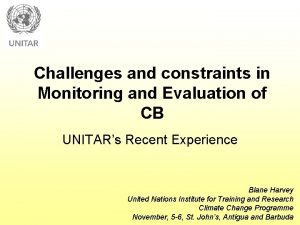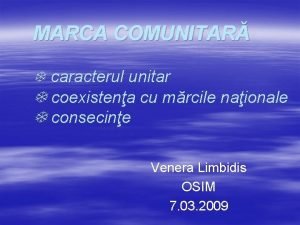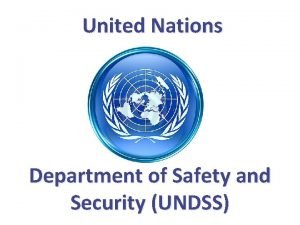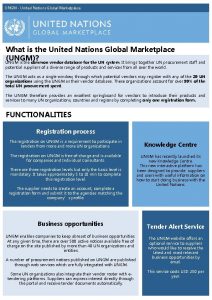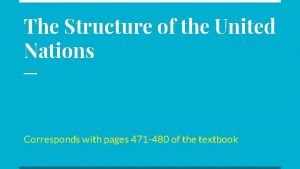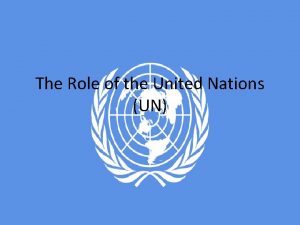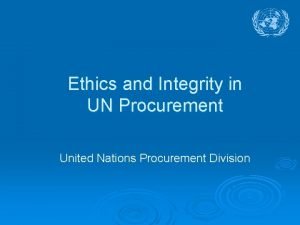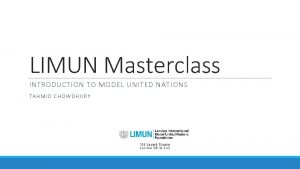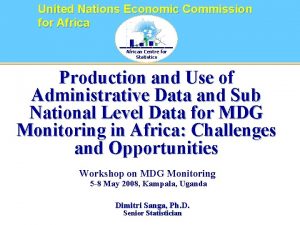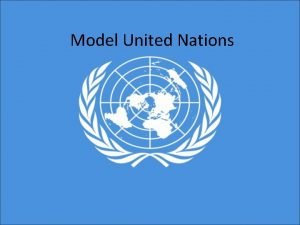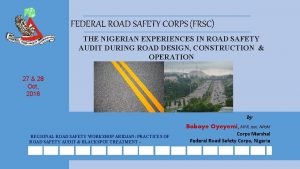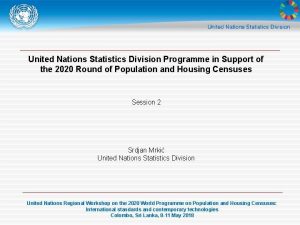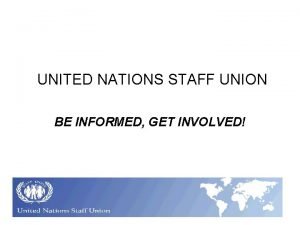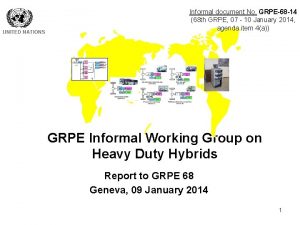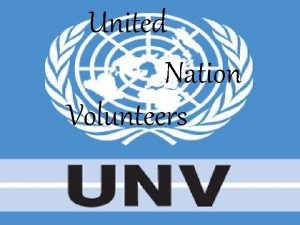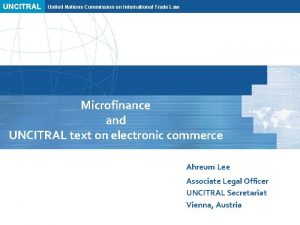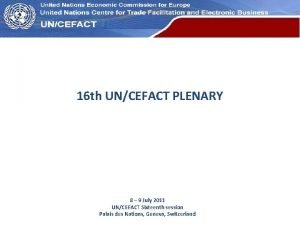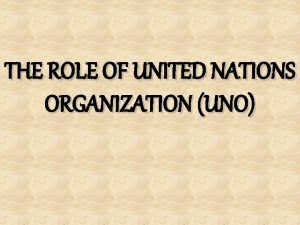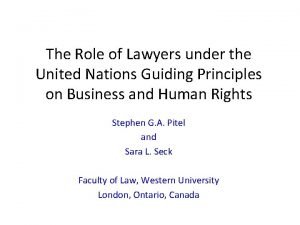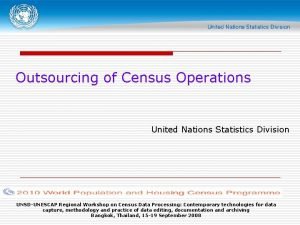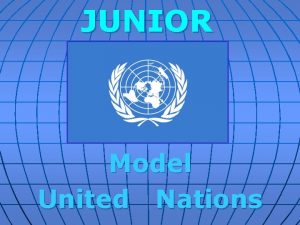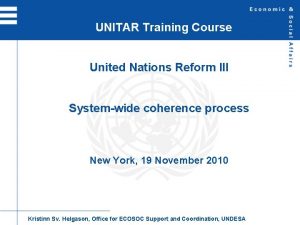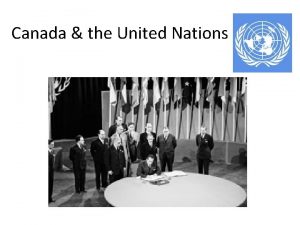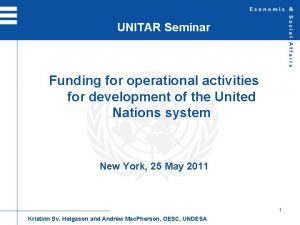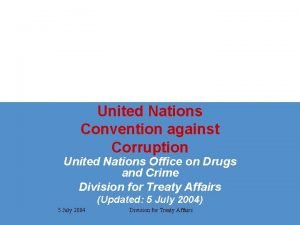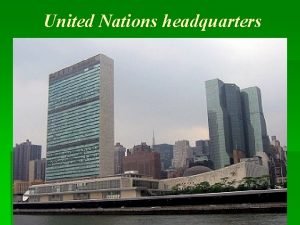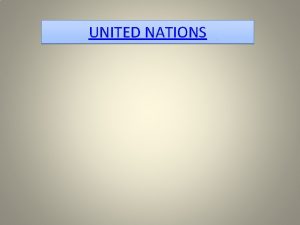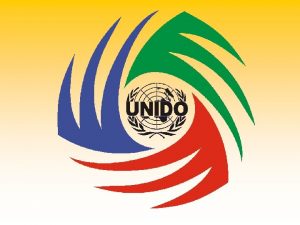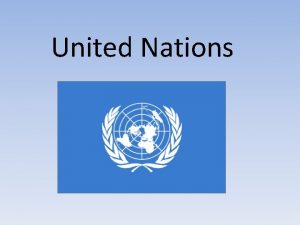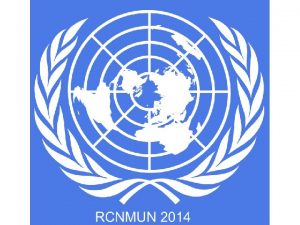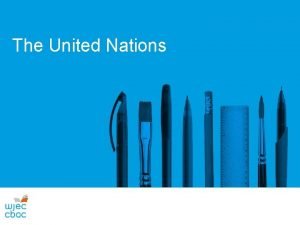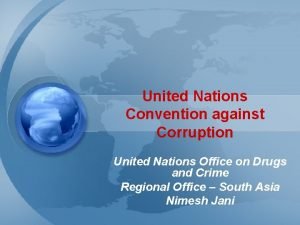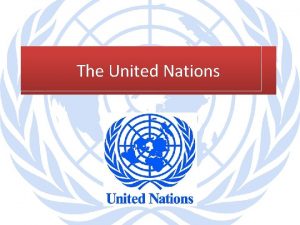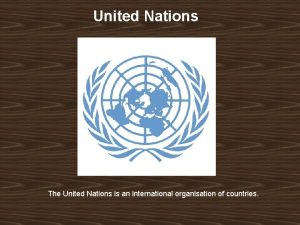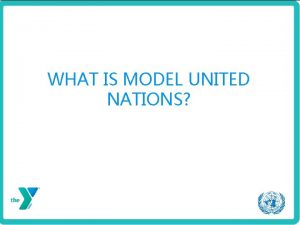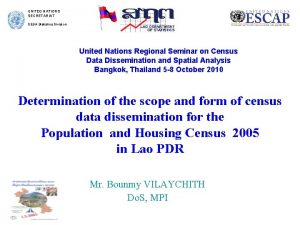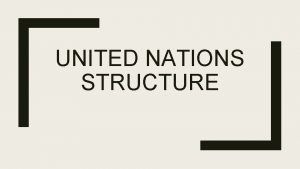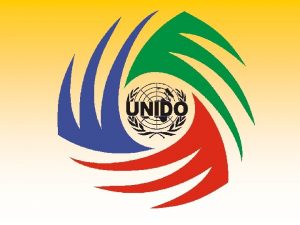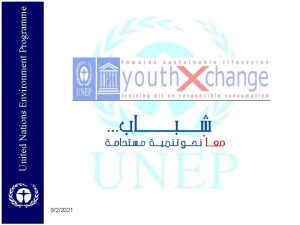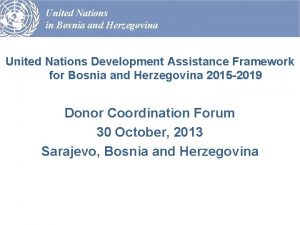UNITAR Training Course United Nations Reform III Operational


























- Slides: 26

UNITAR Training Course United Nations Reform III Operational activities for development New York, 19 November 2010 Nikhil Seth, Director, Office for ECOSOC Support and Coordination, UNDESA

Presentation outline UN Operational activities for development A. Overview B. Historical milestones C. Governance system Nikhil Seth, Director, Office for ECOSOC Support and Coordination, UNDESA

A. Overview UN system-wide activities (Based on average contributions 2006 -2008) Global policy, advocacy, norms and standards 14% Humanitarian Assistance 21% Peacekeeping 22% Developmentrelated activities 43% Nikhil Seth, Director, Office for ECOSOC Support and Coordination, UNDESA

A. Overview Major operational entities (share of total contributions; 2008; $22. 2 billion) • UNICEF 15% • UNHCR 7% WHO 7% • FAO 4% • • UNDP 23% • UNFPA 3% • UNRWA 3% ILO 2% • • UNESCO 2% • WFP 24% • Others 10% • Nikhil Seth, Director, Office for ECOSOC Support and Coordination, UNDESA

A. Overview Destination of expenditures (2008; $18. 6 billion) Nikhil Seth, Director, Office for ECOSOC Support and Coordination, UNDESA

A. Overview Development-related expenditures by sector (2008; $11. 8 billion) Nikhil Seth, Director, Office for ECOSOC Support and Coordination, UNDESA

B. Historical milestones 1945 When UN was established it was not envisaged that organization would become a major player in delivery of operational activities for development Many of the “coherence” challenges which have arisen in UN in recent decades can therefore be traced back to original design of organization Nikhil Seth, Director, Office for ECOSOC Support and Coordination, UNDESA

B. Historical milestones 1945 (cont. ) Functional approach, rather than a federalist one was adopted to design of UN system organized around independent specialized agencies, whose relationship with ECOSOC was established by set of formal agreements, with new organizations created as needs arose Nikhil Seth, Director, Office for ECOSOC Support and Coordination, UNDESA

B. Historical milestones 1946 UNICEF established by GA to provide food, clothing and health care for children 1960 s Many new entities established including WFP (1961), UNCTAD (1964) and UNIDO (1967) Major growth in operational activities of UN system 1965 UNDP is established to coordinate funding for technical assistance provided by other UN entities Nikhil Seth, Director, Office for ECOSOC Support and Coordination, UNDESA

B. Historical milestones 1970 s Continued expansion in UN operational activities for development Post of Director-General for Development and International Cooperation established in 1977 to address growing coordination deficit in UN development system. This function was abolished in 1992 Nikhil Seth, Director, Office for ECOSOC Support and Coordination, UNDESA

B. Historical milestones 1980 s UN system faces funding crisis as some donors withhold contributions at height of Cold War Funding for operational activities for development becomes increasingly earmarked System of execution by UN agencies comes under pressure as programme countries opt for national execution of UN technical assistance Nikhil Seth, Director, Office for ECOSOC Support and Coordination, UNDESA

B. Historical milestones 1990 s Centralized approach to funding through UNDP is gradually abandoned in early 1990 s 1995 UNDP transforms itself from a central fund to being primarily a substantive organization Specialized agencies start mobilizing resources directly from donors, which contributes to rapid growth in non-core funding and fragmentation of UN system Nikhil Seth, Director, Office for ECOSOC Support and Coordination, UNDESA

B. Historical milestones 1995 -2000 Step change towards Member States promoting enhanced programmatic coordination and coherence within UN system 1997 Major reorganization of UN system aimed at strengthening programmatic cooperation and common approaches among UN entities Nikhil Seth, Director, Office for ECOSOC Support and Coordination, UNDESA

B. Historical milestones 1997 (cont. ) Creation of UNDG, chaired by UNDP Administrator Merging of three departments into DESA Establishment of common UN houses Introduction of UNDAF and Common Country Assessment Creation of post of Deputy Secretary-General Establishment of Joint Meeting of Boards of funds and programmes Nikhil Seth, Director, Office for ECOSOC Support and Coordination, UNDESA

B. Historical milestones 2000 s Efforts to strengthen UN development system generally consistent with thrust of 1997 reform with focus on improving field-level coordination and inter-agency cooperation and better measurement of field-level results 2010 Adoption of GA resolution 64/289 on system-wide coherence Nikhil Seth, Director, Office for ECOSOC Support and Coordination, UNDESA

C. Governance system Intergovernmental governance q General Assembly a)Provides overarching normative frameworks for UN development activities, e. g. MDGs, Monterrey Consensus etc. b)Establishes key system-wide policy orientations for UN operational activities for development through quadrennial comprehensive policy review (QCPR) Nikhil Seth, Director, Office for ECOSOC Support and Coordination, UNDESA

C. Governance system Intergovernmental governance q Quadrennial comprehensive policy review Main purpose of QCPR is to evaluate effectiveness and efficiency of UN operational activities for development based on extensive analytical preparations and consultations with stakeholders On basis of QCPR process, GA establishes key system-wide policy orientations for development cooperation and country-level modalities of UN system for four-year period Nikhil Seth, Director, Office for ECOSOC Support and Coordination, UNDESA

C. Governance system Intergovernmental governance q ECOSOC a) Coordinates implementation of global development agenda v High-level Segment v Coordination Segment v Subsidiary bodies (e. g. functional commissions) v Annual Ministerial Review v Development Cooperation Forum Nikhil Seth, Director, Office for ECOSOC Support and Coordination, UNDESA

C. Governance system Intergovernmental governance q ECOSOC (cont. ) b) Coordinates and monitors implementation of policy guidance established by GA in QCPR c) Reviews and evaluates reports on work of funds and programmes v These functions mainly discharged through annual session of Operational Activities Segment of ECOSOC Nikhil Seth, Director, Office for ECOSOC Support and Coordination, UNDESA

C. Governance system Intergovernmental governance q Executive Boards of funds and programmes Responsible, inter alia, for providing intergovernmental oversight of respective entities in accordance with policy guidance established by GA and ECOSOC and for ensuring that respective entities are responsive to needs and priorities of recipient countries Nikhil Seth, Director, Office for ECOSOC Support and Coordination, UNDESA

C. Governance system Intergovernmental governance q Executive Boards of funds and programmes (cont. ) EBs report to ECOSOC and are expected to bring to Council issues that require its attention Executive heads of F/Ps appointed by SG following consultations with EBs and confirmed by GA Nikhil Seth, Director, Office for ECOSOC Support and Coordination, UNDESA

C. Governance system Intergovernmental governance q Governing bodies of specialized agencies SAs are separate, legally autonomous organizations with own policy-making and executive organs, secretariats and budgets Executive heads of SAs elected by membership of respective entity Nikhil Seth, Director, Office for ECOSOC Support and Coordination, UNDESA

C. Governance system Intergovernmental governance q Governing bodies of specialized agencies (cont. ) Relationship of SAs with UN defined in special agreement with ECOSOC and approved by GA ECOSOC can coordinate activities of SAs through consultations with and recommendations to such agencies Nikhil Seth, Director, Office for ECOSOC Support and Coordination, UNDESA

C. Governance system Executive direction and management q Global-level v Chief Executives Board for Coordination Ø High-level Committee on Programmes Ø High-level Committee on Management Ø UN Development Group Nikhil Seth, Director, Office for ECOSOC Support and Coordination, UNDESA

C. Governance system Executive direction and management q Regional-level v. UNDG Regional Teams v. Regional Coordination Mechanisms Nikhil Seth, Director, Office for ECOSOC Support and Coordination, UNDESA

C. Governance system Executive direction and management q National-level v. UN Resident Coordinator System v. UNDAFs v. Common country programmes (One. UN pilots) Nikhil Seth, Director, Office for ECOSOC Support and Coordination, UNDESA
 Monitoring and evaluation challenges
Monitoring and evaluation challenges Unice unitar
Unice unitar United nations
United nations Un department of safety and security
Un department of safety and security Ungm
Ungm Six main organs of the united nations
Six main organs of the united nations Role of united nations
Role of united nations Ethics and integrity at the united nations
Ethics and integrity at the united nations Introduction to model united nations
Introduction to model united nations United nations zambia
United nations zambia United nations
United nations United nations
United nations What is mun
What is mun The agency sponsored by the united nations that compiles
The agency sponsored by the united nations that compiles United nations road safety
United nations road safety Christian saunders united nations
Christian saunders united nations United nations flag
United nations flag United nations statistics division
United nations statistics division Patricia nemeth united nations
Patricia nemeth united nations United nations
United nations Introduction of united nations
Introduction of united nations United nations
United nations United nations economic commission for europe
United nations economic commission for europe Uno flag
Uno flag United nations basic principles on the role of lawyers
United nations basic principles on the role of lawyers United nations statistics division
United nations statistics division Junior model united nations
Junior model united nations
